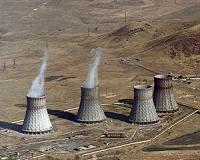 |
Tokyo (UPI) Mar 14, 2011 Japan's earthquake-stricken nuclear power plant was hit with a second explosion Monday, posing a new risk of meltdown. The cooling systems of the three-reactor Fukushima Daiichi plant, 170 miles north of Tokyo, were knocked out after Friday's magnitude 8.9 earthquake, the worst in Japan's history, and subsequent tsunami. The Monday blast in the Number 3 reactor follows a similar explosion Saturday that destroyed part of the Number 1 reactor. Now the Number 2 reactor is threatened. Plant operator Tokyo Electric Power Co. said Monday that the fuel rods in the Number 2 reactor were "fully exposed" at one point after its cooling functions failed, Japanese news agency Kyodo reported. To prevent a possible explosion to that reactor, TEPCO said it was looking into the possibility of making a hole in the wall of the building that houses the reactor in order to release hydrogen. While engineers have been trying to pump seawater around the rods, the Kyodo report suggests this plan may not be working, boosting fears of a potential meltdown. The New York Times said experts had characterized the injection of seawater and neutron-absorbing boron into the plant's three reactor units as a desperation move never before attempted in the industry. Japanese engineer Masashi Goto, who helped design the containment vessel for Fukushima's reactor core, said the design wasn't enough to withstand earthquakes or tsunamis, the BBC reports. Goto says he fears that the blasts at Number 3 and Number 1 reactors may have damaged the steel casing of the containment vessel, which is designed to stop radioactive material from escaping into the atmosphere. But TEPCO said the protective containment shell remains intact following the blasts, Kyodo reports. Because the reactor uses mixed oxide fuel, or mox, it has a melting point that is lower than that of conventional fuel, Goto says. If a meltdown and an explosion occur, the engineer says, plutonium could spread over an area up to twice as far as estimated for a conventional nuclear fuel explosion, he said. So far the government insists that leaked radiation has been nominal. "We believe that there is low possibility that a massive amount of radiation has been leaked," Japanese Chief Cabinet Secretary Yukio Edano told reporters Monday. On Saturday, the government ordered an evacuation of a 12.5-mile radius around the plant. Since the crisis began, 22 people have been treated for effects of radiation, mostly workers at the site; 11 were injured in Monday's blast. Japan has 54 nuclear reactors, supplying about 30 percent of the country's electricity. Japan had aimed for that share to increase to 50 percent by 2017. One of the oldest operating nuclear plants in Japan, Fukushima Daiichi is 40 years old this month.
Share This Article With Planet Earth
Related Links Nuclear Power News - Nuclear Science, Nuclear Technology Powering The World in the 21st Century at Energy-Daily.com
 Nuclear contamination: The options
Nuclear contamination: The optionsParis (AFP) March 13, 2011 Evacuation, temporary shelter and iodine pills are the chief weapons for protecting civilians against nuclear fallout, experts say. A blast on Saturday that wrecked the concrete shell surrounding the No. 1 reactor at Japan's Fukushima nuclear plant released radioactive vapour but not at levels dangerous for human health, according to Japanese officials. Specialists say the authorities ha ... read more |
|
| The content herein, unless otherwise known to be public domain, are Copyright 1995-2010 - SpaceDaily. AFP and UPI Wire Stories are copyright Agence France-Presse and United Press International. ESA Portal Reports are copyright European Space Agency. All NASA sourced material is public domain. Additional copyrights may apply in whole or part to other bona fide parties. Advertising does not imply endorsement,agreement or approval of any opinions, statements or information provided by SpaceDaily on any Web page published or hosted by SpaceDaily. Privacy Statement |